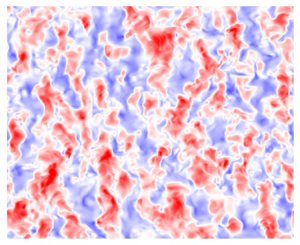Published online by Cambridge University Press: 24 July 2023

This study investigates the coherence of turbulent fluctuations in a turbulent vertical natural convection boundary layer immersed in a stably stratified medium (turbulent buoyancy layer). A turbulent buoyancy layer of a fluid having a Prandtl number of  $0.71$ at a Reynolds number of
$0.71$ at a Reynolds number of  $800$ is numerically simulated using direct numerical simulation. The two-point correlations reveal that the streamwise velocity fluctuations are coherent over large streamwise distances, with the length scale of the streamwise coherence being greater than the boundary layer thickness. This is due to large-scale motions (LSMs), similar to the LSMs observed in canonical wall-bounded turbulence despite the stark differences in flow dynamics. Both high-speed (positive) and low-speed (negative) streamwise velocity fluctuations form LSMs, with their streamwise length scales increasing with increasing wall-normal distance. High-speed LSMs are composed of upwash flow with high temperatures, while low-speed LSMs are composed of downwash flow with low temperatures. Both high-speed and low-speed LSMs meander appreciably in the streamwise direction, with the degree of meandering being correlated with the sign of the spanwise velocity fluctuations. The LSMs exhibit coherence across significant wall-normal distances and contribute significantly to the turbulence production in the outer layer. Examining the one-dimensional energy spectra of the turbulent buoyancy layer shows that the LSMs are the dominant energy-containing motions, implying that the length scale of the energy-containing range is of the order of boundary layer thickness. Notably, wall-normal velocity, spanwise velocity and buoyancy fluctuations do not form LSMs with streamwise length scales comparable to streamwise velocity fluctuations.
$800$ is numerically simulated using direct numerical simulation. The two-point correlations reveal that the streamwise velocity fluctuations are coherent over large streamwise distances, with the length scale of the streamwise coherence being greater than the boundary layer thickness. This is due to large-scale motions (LSMs), similar to the LSMs observed in canonical wall-bounded turbulence despite the stark differences in flow dynamics. Both high-speed (positive) and low-speed (negative) streamwise velocity fluctuations form LSMs, with their streamwise length scales increasing with increasing wall-normal distance. High-speed LSMs are composed of upwash flow with high temperatures, while low-speed LSMs are composed of downwash flow with low temperatures. Both high-speed and low-speed LSMs meander appreciably in the streamwise direction, with the degree of meandering being correlated with the sign of the spanwise velocity fluctuations. The LSMs exhibit coherence across significant wall-normal distances and contribute significantly to the turbulence production in the outer layer. Examining the one-dimensional energy spectra of the turbulent buoyancy layer shows that the LSMs are the dominant energy-containing motions, implying that the length scale of the energy-containing range is of the order of boundary layer thickness. Notably, wall-normal velocity, spanwise velocity and buoyancy fluctuations do not form LSMs with streamwise length scales comparable to streamwise velocity fluctuations.